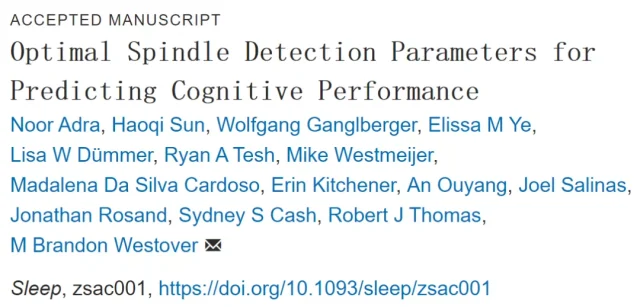Sleep spindles as biomarkers for detection of neurodegenerative diseases
- Why Lecanemab’s Adoption Faces an Uphill Battle in US?
- Yogurt and High LDL Cholesterol: Can You Still Enjoy It?
- WHO Releases Global Influenza Vaccine Market Study in 2024
- HIV Infections Linked to Unlicensed Spa’s Vampire Facial Treatments
- A Single US$2.15-Million Injection to Block 90% of Cancer Cell Formation
- WIV: Prevention of New Disease X and Investigation of the Origin of COVID-19
Sleep spindles can be used as biomarkers for detection of neurodegenerative diseases
- Red Yeast Rice Scare Grips Japan: Over 114 Hospitalized and 5 Deaths
- Long COVID Brain Fog: Blood-Brain Barrier Damage and Persistent Inflammation
- FDA has mandated a top-level black box warning for all marketed CAR-T therapies
- Can people with high blood pressure eat peanuts?
- What is the difference between dopamine and dobutamine?
- How long can the patient live after heart stent surgery?
Sleep spindles can be used as biomarkers for detection of neurodegenerative diseases.
Sleep spindles , brain activity that occurs abundantly during non-REM sleep, are associated with cognitive function. It can be assessed by electroencephalography (EECs) with non-invasive electrodes placed on the scalp .
Sleep spindles are considered a “fingerprint” that varies between individuals, are highly heritable, and tend to be consistent during the night. But there is currently no consensus on which sleep spindle parameters are important.
With aging worldwide and the rising burden of neurodegenerative disease, there is an urgent need for a sensitive cognitive biomarker.
Clinicians may evaluate certain brain wave patterns that occur during an individual’s sleep to help them diagnose dementia and other disorders related to memory, language, and thinking.
Recently, researchers at Massachusetts General Hospital and Beth Israel Deaconess Medical Center published a research paper titled: Optimal Spindle Detection Parameters for Predicting Cognitive Performance in the journal Sleep .
The new study describes how spindle detection parameter settings affect the association between spindles and cognition, and identifies the parameters most associated with cognitive performance .
This could help improve automated methods of detecting these brainwave patterns, or sleep spindles, and linking them to cognitive function.
“With the rising burden of neurodegenerative disease, there is an urgent need for a sensitive cognitive biomarker,” said lead author Noor Adra , a clinical research fellow at Massachusetts General Hospital . “This has led to a rush to study sleep spindles — a Oscillating patterns of brain activity observed during sleep and their role in various neuropsychiatric conditions and cognitive performance.”
Although sleep spindles and other brain features represent potential electrophysiological markers of neurodegenerative and psychiatric disorders, detecting and assessing sleep spindles is not straightforward.
“It’s been known that these brief, high-frequency events in the brain during sleep are closely related to cognition, especially learning and memory,” said co-author Haoqi Sun , Ph.D. , a researcher in the Department of Neurology at Massachusetts General Hospital .
When trying to detect spindles in over 100 sleep recordings, things become less clear, such as what is the optimal threshold, what is the optimal minimum duration, etc.”
Sleep spindles are usually analyzed by visual inspection of the EEG, but automated methods can provide more consistent results.
However, there is no consensus on the parameters of this automated method.
To address these questions, the researchers designed sleep-related experiments involving 167 adults to describe how spindle detection parameter settings affect the association between spindle features and cognition, and to identify the parameters most associated with cognitive performance.
The team also found that sleep spindles are closely related to so-called fluid intelligence , which relies on abstract thinking and problem-solving skills, and declines in the early stages of dementia.
Adra said: “Our findings therefore support sleep spindles as a sleep-based biomarker of fluid intelligence.
By optimizing the detection of this sleep-based cognitive biomarker, we hope to guide future studies to detect Sensitivity of this biomarker in the neurodegenerative population.”
“The sleep spindle is one of many important measurable features of brain activity during sleep, and it provides an insight into the current state of brain health and individual afflictions,” added M. Brandon Westover , Ph. window of risk for brain disease or cognitive decline.
Now that we better understand how sleep spindles are measured, we can add to the growing pool of information on brain health — health metrics that can be measured during sleep, These indicators will be important tools in our quest to develop treatments that protect and enhance brain health.”
Reference :
https://doi.org/10.1093/sleep/zsac001
https://www.massgeneral.org/news/press-release/sleep-brain-wave-patterns-to-diagnose-dementia
Sleep spindles can be used as biomarkers for detection of neurodegenerative diseases.
(source:internet, reference only)
Disclaimer of medicaltrend.org
Important Note: The information provided is for informational purposes only and should not be considered as medical advice.




